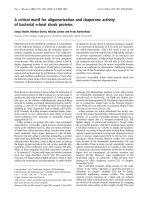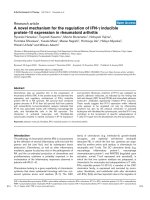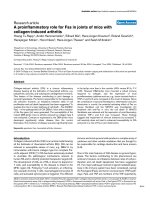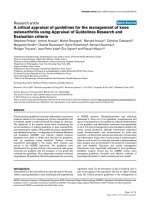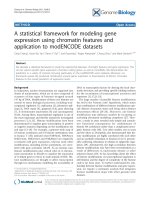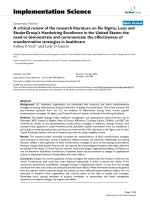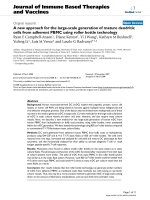Báo cáo Y học: A critical motif for oligomerization and chaperone activity of bacterial a-heat shock proteins pot
Bạn đang xem bản rút gọn của tài liệu. Xem và tải ngay bản đầy đủ của tài liệu tại đây (540.47 KB, 9 trang )
A critical motif for oligomerization and chaperone activity
of bacterial a-heat shock proteins
Sonja Studer, Markus Obrist, Nicolas Lentze and Franz Narberhaus
Institute of Microbiology, Eidgeno
¨
ssische Technische Hochschule, Zu
¨
rich, Switzerland
Oligomerization into multimeric complexes is a prerequisite
for the chaperone function of almost all a-crystallin type
heat shock proteins (a-Hsp), but the molecular details of
complex assembly are poorly understood. The a-Hsp pro-
teins from Bradyrhizobium japonicum are suitable bacterial
models for structure-function studies of these ubiquitous
stress proteins. They fall into two distinct classes, A and B,
display chaperone activity in vitro and form oligomers of
24 subunits. We constructed 19 derivatives containing
truncations or point mutations within the N- and C-terminal
regions and analyzed them by gel filtration, citrate synthase
assay and coaffinity purification. Truncation of more than
the initial few amino acids of the N-terminal region led to the
formation of distinct dimeric to octameric structures devoid
of chaperone activity. In the C-terminal extension, integrity
of an isoleucine-X-isoleucine (I-X-I) motif was imperative
for a-Hsp functionality. This I-X-I motif is one of the
characteristic consensus motifs of the a-Hsp family, and here
we provide experimental evidence of its structural and
functional importance. a-Hsp proteins lacking the C-termi-
nal extension were inactive, but still able to form dimers.
Here, we demonstrate that the central a-crystallin domain
alone is not sufficient for dimerization. Additional residues
at the end of the N-terminal region were required for the
assembly of two subunits.
Keywords: a-crystallin; a-heat shock protein; small heat
shock protein; chaperone; oligomerization.
Heat shock or other forms of stress induce the expression of
a-heat shock proteins (a-Hsp proteins) in a broad range of
prokaryotic and eukaryotic organisms [1–5]. a-Hsp proteins
take part in the cellular multichaperone protein-folding
network by binding to partially denatured proteins, thereby
creating a reservoir of unfolded proteins for subsequent
refolding by other chaperones such as DnaK and GroEL
[6–8]. Virtually all a-Hsp proteins examined display chap-
erone activity in vitro, measured by their ability to protect
model substrates from thermally or chemically induced
aggregation [8–13].
a-Hsp proteins are named after their most prominent
representative, a-crystallin, which prevents protein precipi-
tation in the vertebrate eye lens. They are mostly referred to
as small heat shock proteins (sHsp), because their mono-
meric molecular mass ranges between 12 and 43 kDa.
However, the term sHsp is somewhat misleading, as several
other small heat-inducible proteins bear no resemblance to
a-Hsp proteins. Moreover, native a-Hsp proteins are among
the largest protein particles in the cell, as they assemble into
complexes whose molecular mass often exceeds 500 kDa.
Many of these complexes have been reported to consist of
24 subunits [13–16], but both larger and smaller structures
have also been described [11,12,17,18]. The quaternary
structure of a-Hsp proteins is highly dynamic, which is often
reflected by pronounced size heterogeneity or rapid subunit
exchange [19]. Mammalian members of the a-Hsp family
are remarkably polydisperse [20,21], and some bacterial
proteins such as Escherichia coli IbpB also display pro-
nounced size heterogeneity [22]. Particularly rigid structures
are of prokaryotic origin, such as the 24-meric Hsp16.5
from Methanococcus jannaschii or nonameric Hsp16.3 from
Mycobacterium tuberculosis [11,14].
a-Hsp proteins are widely distributed but poorly con-
served. One major characteristic of this protein family is the
presence of a central a-crystallin domain, flanked by a
N-terminal region and a C-terminal extension [23]. The
highest degree of amino-acid similarity is found within
the a-crystallin domain, while the N-terminal region and the
C-terminal extension are variable in length and sequence.
Naturally occurring a-Hsp proteins lacking these flanking
regions acquire monomeric to tetrameric structures and are
poor or inactive chaperones [24,25]. In the last few years,
systematic a-Hsp structure–function studies have mainly
been focused on the mammalian representatives aA- and
aB-crystallin. These proteins proved remarkably resistant
against mutational alterations. For example, a wide variety
of truncations and point mutations within the N-terminal
region had no consequence on protein structure and
function [26–30]. However, some modifications in the
N-terminal region of eukaryotic a-Hsp proteins were
reported to affect chaperone activity [31] or complex
formation [26,32].
The C-terminal extension, being located on the outer
surface of the a-Hsp oligomers, is generally assumed to
contribute to complex solubility [33], but its further
functional implication remains unclear. The recently
resolved crystal structures of a plant and an archaeal
a-Hsp show that in these proteins, the C-terminal extensions
are involved in subunit–subunit interactions by strapping
around the outer surface of the complex [14,34]. The most
Correspondence to F. Narberhaus, Institute of Microbiology,
ETH-Zentrum, Schmelzbergstrasse 7, CH-8092 Zu
¨
rich, Switzerland.
Fax: + 41 1632 1148, Tel.: + 41 1632 2586,
E-mail:
Abbreviations: a-Hsp, a-crystallin type heat shock protein; sHsp, small
heat shock protein; CS, citrate synthase.
(Received 1 March 2002, revised 25 April 2002, accepted 17 June 2002)
Eur. J. Biochem. 269, 3578–3586 (2002) Ó FEBS 2002 doi:10.1046/j.1432-1033.2002.03049.x
striking feature of the poorly conserved C-terminal exten-
sion is the presence of an isoleucine-X-isoleucine (I-X-I)
motif in the majority of a-Hsp proteins. This I-X-I (or, more
generally, I/V-X-I/V) motif was recognized as one of the
three main consensus regions of the a-Hsp family [5]. There
is little experimental evidence to circumstantiate the role of
the C-terminal extension, and even less concerning the
conserved I-X-I motif. Various modifications within the
C-terminal extension decreased chaperone activity of
a-crystallin and other vertebrate a-Hsp proteins
[27,31,33,35], but only in the case of one plant a-Hsp were
C-terminal truncations observed to reduce complex size [36].
Altogether, the oligomerization principles of a-Hsp
proteins, and especially of their bacterial representatives,
are still poorly understood. We found in previous studies
that the soil bacterium Bradyrhizobium japonicum is a
suitable model organism for investigating prokaryotic
a-Hsp proteins [4,13,37]. It contains at least 10 a-Hsp
proteins, which are highly induced upon heat shock [4]. The
sequences of seven B. japonicum a-Hsp genes are available
and can be assigned to two distinct classes, A and B. These
two classes are not restricted to B. japonicum, but also occur
in other rhizobia [38]. Members of both classes have been
shown to prevent citrate synthase aggregation in vitro,to
form 400- to 500-kDa complexes and to interact with other
a-Hsp proteins of the same class [13].
The present study demonstrates that chaperone activity
of B. japonicum a-Hsp proteins is stringently coupled to
multimerization, and that both the N- and C-terminal
regions are required for the formation of chaperone-
competent complexes. In particular, we show that integrity
of the I-X-I motif is critical for assembly of functional a-Hsp
proteins, and that the isolated a-crystallin domain is unable
to dimerize.
EXPERIMENTAL PROCEDURES
Plasmid construction
Plasmids for the expression of B. japonicum hspF (pRJ5306)
and hspH (pRJ5307) provided with a C-terminal His
6
tag
have been described previously [13]. N- or C-terminal
truncations of hspF and hspH were constructed by PCR,
using pRJ5306 and pRJ5307 as templates. For subsequent
cloning, we took advantage of two unique restriction sites,
namely BsaIonhspF and SfiIonhspH. PCR products were
digested with either BsaIorSfiIandNdeI(N-terminal
truncations) or NotI (C-terminal truncations). The purified
fragments were used to replace the corresponding wild-type
fragments in pRJ5306 or pRJ5307. hspH variants encoding
the isolated a-crystallin domain or the a-crystallin domain
including either the N-terminal region or the C-terminal
extension were constructed in a similar manner. Mutations
leading to single and double amino-acid exchanges were
introduced into hspH by means of the QuickChange
TM
Site-
Directed Mutagenesis Kit (Stratagene). Expression vector
pRJ5307 was used as a template, and mutagenesis was
performed according to the manufacturer’s instructions. All
resulting plasmids encoded a-Hsp versions carrying a His
6
tag at the C-terminus. A plasmid for the expression of an
untagged hspH variant lacking the C-terminal extension was
constructed by introducing a stop codon followed by an
XhoI site by PCR. The amplification product was digested
with NdeIandXhoI and ligated into a pET24b vector
digested with the same endonucleases. The correct nucleo-
tide sequence of all inserts was confirmed by automated
DNA sequencing.
Protein expression and purification
Freshly transformed E. coli BL21(DE3)pLysS strains were
used for protein expression. Overexpression cultures were
grown at 30 °CtoD
600
¼ 0.6, induced by addition of
isopropyl thio-b-
D
-galactoside to a final concentration of
0.5 m
M
, and grown for a further 2–3 h. After harvesting,
cells were resuspended in binding buffer (500 m
M
KCl,
20 m
M
Tris/HCl, 5 m
M
imidazole, pH 7.9) containing
1m
M
phenylmethanesulfonyl fluoride and 10 lgÆmL
)1
DNaseI. Lysis was performed in a French pressure cell at
1000 p.s.i, and soluble crude extracts were prepared by
centrifugation at 12 000 g for 30 min at 4 °C.
Proteins were purified by Ni-nitrilotriacetic acid affinity
chromatography (Ni-nitrilotriacetic acid resin from Qiagen)
under native conditions essentially as described previously
[13]. The column was pre-equilibrated with binding buffer
and then washed with washing buffer (500 m
M
KCl, 20 m
M
Tris/HCl, pH 7.9) containing increasing imidazole concen-
trations (5–50 m
M
). The imidazole concentration was finally
raised to 250 m
M
in order to elute bound proteins. If protein
purity was not satisfactory, the eluate was diluted to an
imidazole concentration below 50 m
M
andappliedtoa
second column, either Ni-nitrilotriacetic acid/agarose (Qia-
gen) or Co-PDC/agarose (Acros Organics). Whenever
possible, proteins were analyzed by gel filtration and citrate
synthase assay immediately after purification. Otherwise,
eluates were supplemented with 20% glycerol and stored at
)20 or )80 °C. Protein concentrations were determined by
the Bradford assay. All protein concentrations reported in
this study are expressed in terms of protomers.
Chaperone activity assay
Chaperone activity was determined by the citrate synthase
(CS) assay. a-Hsp proteins were preincubated at 43 °Cin
1mL of 50m
M
sodium phosphate, pH 6.8, for at least
15 min. The assay was started by addition of CS to a final
concentration of 600 n
M
. CS aggregation was measured by
monitoring light scattering at 360 nm for 30 min in an
Ultrospec 3000 spectrophotometer (Amersham Pharmacia
Biotech). Prior to use, CS (Sigma) was dialyzed against Tris/
EDTA buffer (10 m
M
Tris/HCl, 1 m
M
EDTA, pH 8.0).
For each protein, chaperone activity assays were performed
at least twice with preparations from independent purifica-
tions.
Gel filtration
Analytical size exclusion chromatography of purified pro-
teins was performed at room temperature on a Superdex
200 HR 30/10 column (Amersham Pharmacia Biotech)
using a BioCAD perfusion chromatography system
(PerSeptive Biosystems). After equilibrating the column
with elution buffer (500 m
M
KCl, 20 m
M
Tris/HCl, 250 m
M
imidazole, pH 7.9), 200-lL protein samples were injected
and separated at a flow rate of 0.6 mLÆmin
)1
. Absorbance
was recorded at 280 nm. The following standards were used
Ó FEBS 2002 A cricital motif for a-Hsp oligomerization (Eur. J. Biochem. 269) 3579
for calibration: thyroglobulin (669 kDa), ferritin (440 kDa),
aldolase (158 kDa), albumin (67 kDa), and ribonuclease A
(13.7 kDa), all from Amersham Pharmacia Biotech. Gel
filtrations were performed at least twice with protein
obtained from independent preparations.
Co-affinity purification
Copurification of untagged a-Hsp proteins with His
6
-tagged
variants by Ni-nitrilotriacetic acid affinity chromatography
was used to investigate protein–protein interactions of certain
truncated a-Hsp proteins. The applied denaturation–renat-
uration protocol has been described previously [13].
RESULTS
Construction of HspH and HspF derivatives
for structure-function studies
In order to study the principles of a-Hsp assembly and the
relation between complex formation and chaperone activity,
we constructed a series of truncated and point-mutated
a-Hsp variants. A total of 19 a-Hsp derivatives were
analyzed in the course of this study. An overview of these
constructs is given in Fig. 1. The alignment presents the
seven known a-Hsp sequences from B. japonicum, i.e. five
class A (HspA, HspB, HspD, HspE and HspH) and two
class B proteins (HspC and HspF), as well as the class A
E. coli proteins IbpA and IbpB. A representative example
from each class, A (HspH) and B (HspF), was chosen for
further analysis.
The N-terminal region of HspH and HspF was gradually
shortened by eliminating an increasing number of amino-
acid residues. The resulting proteins were named HspH
(D3N), HspH(D9N), HspH(D15N), HspH(D20N), and
HspF(D5N), HspF(D30N), HspF(D40N). In HspH(D20N)
and HspF(D40N), approximately half of the N-terminal
region was eliminated, including a proline and an arginine
residue conserved in all seven B. japonicum a-Hsp proteins
(Fig. 1). To examine the importance of these two particular
residues, we constructed two HspH derivatives in which the
proline (P8A) or the arginine (R18A) was replaced by an
alanine.
The characteristic I-X-I motif in the C-terminal extension
is present in all B. japonicum and E. coli a-Hsp proteins. To
investigate its role in oligomerization, we constructed two
a-Hsp derivatives lacking one [HspF(D5C)] or both
[HspH(D20C)] isoleucine residues. Two further constructs,
HspH(D5C) and HspH(D15C), contained the entire I-X-I
motif. To assess the role of the conserved motif in the
context of the full-length protein, three HspH variants were
constructed, in which the isoleucines were replaced by
alanine, either individually, resulting in HspH(I133A) and
HspH(I135A), or simultaneously, leading to
HspH(II133,135AA).
Finally, we searched for the minimal fragment required
for dimer formation. For this purpose HspH variants
lacking entire subregions were constructed. Three proteins,
Fig. 1. Amino-acid alignment of B. japonicum and E. coli a-Hsp proteins. The alignment includes the seven known sequences of B. japonicum a-Hsp
proteins, belonging to class A [HspH (accession number O86110), HspA (P70917), HspB (P70918), HspD (O69241) and HspE (O69242)] and B
[HspC (AAC44757) and HspF (CAA05837)]. IbpA (P29209) and IbpB (G65170) from E. coli (both class A) were added for comparison. The
alignment was created with
CLUSTAL W
[48]. Amino acids that are identical in all analyzed proteins are shown in white letters shaded in black. White
letters and black letters shaded in grey indicate amino acids that are identical in at least 80 or 60% of all proteins, respectively. Arrows mark
truncations introduced to HspH and HspF, and asterisks indicate alanine exchange mutations in HspH. Note that four N-terminal residues were
included in HspH(a) and HspH(aC) to avoid disturbance of potential secondary structures.
3580 S. Studer et al. (Eur. J. Biochem. 269) Ó FEBS 2002
consisting of the a-crystallin domain alone [HspH(a)], the
a-crystallin domain plus the N-terminal region [HspH(Na)],
or the a-crystallin domain followed by the C-terminal
extension [HspH(aC)], were analyzed.
Alterations in the N-terminal region affect chaperone
activity and oligomerization
As demonstrated previously [13], full-length class A and
class B a-Hsp proteins of B. japonicum act as efficient
chaperones in vitro (Fig. 2H,I). They form oligomers with
an apparent molecular mass of 400–500 kDa, which
corresponds to a complex of 24 subunits ([13]; for
comparison with mutated variants see gel filtration profiles
in Fig. 3H–J). These features were not affected if the
N-terminus was shortened by just a few amino-acid
residues. HspH(D3N) and HspF(D5N) could not be distin-
guished from native HspH and HspF with regard to
chaperone activity and oligomeric state. They prevented CS
aggregation (Fig. 2A,E), and their apparent molecular mass
of 350–480 kDa was consistent with oligomers of 20–30
subunits (Fig. 3A,E). Thus, the integrity of the extreme
N-terminus is not relevant for the assembly of functional
a-Hsp complexes.
Removal of additional amino acids, however, drastically
altered the characteristics of either protein. HspH(D9N),
HspH(D15N) and HspH(D20N) were devoid of chaperone
activity (Fig. 2B–D) and unable to assemble into large
oligomers. Instead, they formed complexes consisting of
approximately eight subunits (Fig. 3B–D). Oligomerization
was only partially compromised, whereas chaperone activity
was completely abolished. Note that in many gel filtration
runs [e.g. HspH or HspH(D3N)], a considerable portion of
the protein eluted after 12–13 min in the void volume of the
column, reflecting the tendency of all B. japonicum a-Hsp
proteins to form large aggregates. Extended truncations in
the N-terminal region of HspF caused similar, but not
identical effects as in HspH. When 30 or more amino-acid
residues were removed from the N-terminus of HspF,
chaperone activity was completely lost (Fig. 2F,G) and
oligomer formation was impaired even more drastically
than in the HspH derivatives. Gel filtration analysis of
HspF(D30N) and HspF(D40N) suggested that both pro-
teins were only dimers (Fig. 3F,G), whereas HspH deri-
vatives devoid of the first half of the N-terminal region
[HspH(D20N)] appeared as octameric complexes. In either
case, it is evident that a largely intact N-terminal region
is strictly required for the formation of active a-Hsp
oligomers.
In an attempt to narrow down the critical determinants to
the amino-acid level, we tested the effect of two single
amino-acid exchanges (P8A and R18A) on chaperone
activity and oligomeric state of HspH. Although these
residues are conserved throughout class A and class B
proteins of B. japonicum (Fig. 1), neither exchange inhibited
chaperone activity and oligomerization (data not shown).
Fig. 2. Effect of truncations in the N-terminal
region on chaperone activity of HspH and
HspF. Thermally induced aggregation of
citrate synthase at 43 °Cisdepictedasa
function of time in the presence of various
amounts of a-Hsp proteins. (A–D), N-termi-
nally truncated variants of HspH (class A);
(E–G), N-terminally truncated variants of
HspF (class B). Chaperone activity of
full-length HspH and HspF is shown for
comparison (H, I). Proteins were incubated at
43 °C in a total volume of 1.0 mL of 50 m
M
phosphate buffer, pH 6.9. CS aggregation was
measured by the increase of absorbance at
360 nm in the absence (r) and in the presence
of a-Hsp proteins at a final concentration of
150 n
M
(j), 300 n
M
(m), 600 n
M
(·)and
1.2 l
M
(d). The CS concentration was
600 n
M
. Absorbance of a-Hsp proteins in the
absenceofCSisalsoshown(S).
Ó FEBS 2002 A cricital motif for a-Hsp oligomerization (Eur. J. Biochem. 269) 3581
Two conserved isoleucines are essential for a-Hsp
functionality
When assessing the impacts of C-terminal truncations on
oligomerization and chaperone function, we focused our
attention on the conserved I-X-I motif. First, the C-terminal
extension of HspH was shortened by five and 15 amino
acids [HspH(D5C) and HspH(D15C), respectively], leaving
the I-X-I motif intact. These alterations had no influence on
chaperone activity. Both proteins efficiently protected CS
from thermally-induced aggregation (Fig. 4A,B) and as-
sembled into large complexes (Fig. 5A,B). But while
HspH(D5C) appeared similar to full-length HspH in terms
of oligomer formation, HspH(D15C) formed larger aggre-
gates with an apparent molecular mass exceeding 2 MDa.
All C-terminally truncated a-Hsp derivatives exhibited an
increased tendency to precipitate.
Elimination of the entire I-X-I motif in HspH(D20C)
led to a complete loss of chaperone activity (Fig. 4C) and
a protein that was unable to multimerize. The only species
encountered in the gel filtration profile was a dimer of
29 kDa (Fig. 5C). Removal of the C-terminal isoleucine
from the I-X-I motif in HspF(D5C) was sufficient to
completely abolish chaperone activity (Fig. 4D) and
Fig. 3. Oligomerization of N-terminally truncated HspH and HspF derivatives. The oligomeric state of purified a-Hsp variants was determined by gel
filtration over a Superdex 200 column at a flow rate of 0.6 mLÆmin
)1
. N-Terminally truncated derivatives of HspH (A–D) and HspF (E–G) were
analyzed and compared with native HspH (H) and HspF (I). The minor peak at 12–13 min that is observed in all gel filtration profiles represents
large protein aggregates eluting in the column’s void volume. J, calibration curve for the gel filtration profiles in (A–I). K
av
¼ (V
e
) V
0
)/(V
t
) V
0
)is
depicted as a function of log molecular mass (V
e
¼ elution volume of the protein, V
0
¼ column void volume, V
t
¼ total bed volume). Open circles
represent standard proteins listed in Experimental procedures (molecular masses given in kDa), filled circles indicate HspH and HspF variants. Only
major peaks aside from the void volume are indicated.
Fig. 4. Effect of truncations and single amino
acid exchanges in the C-terminal extension on
chaperone activity of HspH and HspF. Chap-
erone activity of purified a-Hsp proteins was
determined by the CS aggregation assay as
outlined in the legend of Fig. 2. (A–C)
C-Terminally truncated variants of HspH. (D)
C-Terminally truncated variant of HspF; E-G,
point mutated variants of HspH. Depicted is
CS aggregation in the absence (r)andinthe
presence of a-Hsp proteins at final concen-
trations of 150 n
M
(j), 300 n
M
(m), 600 n
M
(·)and1.2l
M
(d); as well as the absorbance
of a-Hsp proteins in the absence of CS (S).
3582 S. Studer et al. (Eur. J. Biochem. 269) Ó FEBS 2002
severely impaired oligomer formation (Fig. 5D). The
apparent molecular mass of 44–48 kDa probably repre-
sents a dimer.
As both truncations affecting the I-X-I motif impaired
chaperone activity and oligomer formation, we replaced the
two isoleucine residues in HspH by alanines and analyzed
whether these mutations had a similar effect. In fact,
HspH(I133A), HspH(I135A) and HspH(II133,135AA)
were devoid of chaperone activity (Fig. 4E–G) and
appeared as small, dimeric structures of 43–50 kDa
(Fig. 5E–G). Summarizing the gel filtration data, the
calibration curve in Fig. 5H illustrates that all modifications
affecting the I-X-I motif resulted in the formation of small,
presumably dimeric complexes. Taken together, these
results demonstrate that the isoleucine motif plays a crucial
structural and functional role in the assembly of functional
HspH or HspF oligomers.
The a-crystallin domain alone is not sufficient
for dimer formation
All HspF and HspH variants investigated so far acquired
dimeric structures, indicating that the dimerization motif
remained untouched. In order to determine the a-Hsp
region responsible for dimerization, we initially attempted
to purify the isolated a-crystallin domain. As the protein
repeatedly showed a strong tendency to precipitate and
could only be recovered in concentrations too low for size
exclusion chromatography, we used an alternative approach
instead. The interaction of full-length HspH with a series of
truncated His
6
-tagged HspH variants, i.e. HspH(a)–His
6
,
HspH(Na)–His
6
,HspH(aC)–His
6
and HspH(HD20N)–
His
6
was tested. Crude extracts containing tagged and
untagged protein were mixed, denatured and renatured
before being applied to Ni-nitrilotriacetic acid affinity
columns. The eluted proteins were subsequently analyzed
by SDS/PAGE. Co-elution of the untagged protein together
with the His
6
-tagged species was indicative of protein–
protein interactions, whereas proteins that did not interact
with the His
6
-tagged species were not retained on the
column [13].
Untagged HspH did not coelute with the His
6
-tagged
a-crystallin domain (Fig. 6A), suggesting that the isolated
a-crystallin domain was unable to dimerize. The a-crys-
tallin domain carrying the C-terminal extension appeared
to enable weak interactions with native HspH, because
after copurification of HspH(aC)–His
6
with HspH, a faint
band corresponding to HspH was visible on SDS gels. In
contrast, HspH(Na)–His
6
, an HspH derivative consisting
of the a-crystallin domain plus the N-terminal region,
strongly interacted with native HspH. After co-affinity
purification, both proteins were detected on SDS gels in a
1 : 1 ratio. A similarly efficient copurification of HspH
was observed with HspH(D20N)–His
6
. This suggests that
the a–Hsp interaction is in part mediated by a portion of
the N-terminal region in vicinity of the a-crystallin
domain.
To ensure that efficient dimerization requires solely
a-crystallin domain and N-terminal region and not the
C-terminal extension, HspH(Na)–His
6
was also subjected to
a copurification assay with untagged HspH(Na). The latter
protein alone did not bind to the Ni-nitrilotriacetic acid resin
(Fig. 6B, lane 5). However, it co-eluted with HspH(Na)–
His
6
(Fig. 6B, lane 4). Size exclusion chromatography
confirmed that HspH(Na) was present as small, presumably
dimeric species, which were, as expected, devoid of chaper-
one activity (data not shown). Thus, dimer formation does
not depend on the integrity of the C-terminal extension but
requires part of the N-terminal region.
DISCUSSION
Up to now, systematic a-Hsp structure–function studies
have almost exclusively focused on a-crystallins from higher
organisms. Introduction of mutations often had little impact
on oligomerization and chaperone activity, as mammalian
a-Hsp proteins are very resistant to mutational changes
owing to their intrinsic plasticity [20,26–30,39]. In compar-
Fig. 5. Oligomerization of HspH and HspF derivatives with alterations in the C-terminal extension. Gel filtration profiles of a-Hsp derivatives with
truncations or point mutations in the C-terminal extension are shown. (A–C) C-Terminally truncated variants of HspH; (D) C-terminally truncated
variant of HspF; E-G, point mutated variants of HspH. See Fig. 3H,I for the gel filtration profiles of HspH and HspF. The minor peak at
12–13 min observable in most gel filtration profiles represents large protein aggregates eluting in the column’s void volume. (H) calibration curve for
the gel filtration profiles depicted in (A–G). Standard proteins (molecular masses given in kDa) are represented by open circles, HspH and HspF
variants by filled circles. HspH(D15C) eluting in the void volume of the column was not included.
Ó FEBS 2002 A cricital motif for a-Hsp oligomerization (Eur. J. Biochem. 269) 3583
ison with mammalian a-crystallins, the oligomerization
principles of bacterial a-Hsp proteins have received little
attention. Available data indicate that a-Hsp proteins from
prokaryotes and plants may differ significantly from their
mammalian counterparts in structure and function [40,41].
Some prokaryotic a-Hsp proteins possess remarkably rigid
structures [11,14] that render them more susceptible to point
mutations and truncations. We therefore chose two dis-
tantly-related bacterial a-Hsp proteins from B. japonicum in
order to study, in detail, the contribution of their subregions
to chaperone activity and oligomerization.
Tight coupling of chaperone activity
and complex assembly
B. japonicum HspH and HspF oligomers contain 24
subunits, as shown previously with crude extracts [13] and
confirmed with purified proteins in the present study.
Transmission electron microscopical analysis of both pro-
teins revealed roughly spherical structures (data not shown)
similar to those observed for other members of the a-Hsp
family [10,12,20,21].
We have demonstrated that assembly of this native
structure is severely impaired by truncations in the
N-terminal region and the C-terminal extension. Interest-
ingly, all of the resulting low molecular mass complexes
were devoid of chaperone activity. Although we cannot rule
out that the truncated proteins had lost substrate binding
regions in addition to oligomerization sites, this finding
illustrates that chaperone activity and oligomerization are
tightly coupled. The ability to bind unfolded proteins and
prevent them from aggregation clearly requires fully
assembled multimeric a-Hsp complexes. Even complexes
that exceed the size of the wild-type protein, e.g.
HspHD15C, retained chaperone activity. Much like our
a-Hsp variants, naturally occurring multimerization-incom-
petent a-Hsp proteins have poor or lacking chaperone
activity [24,25,42]. The chaperone activity of mammalian
a-crystallins, on the other hand, appears to be much more
resistant against structural modifications. Human aB-crys-
tallin does not require a multimeric a-Hsp complex for
chaperone activity [43]. The functional, substrate-binding
entity might actually be an a-Hsp dimer rather than the fully
oligomerized particle, which is regarded as a transient
storage form of the chaperone [34,44].
Prerequisites for dimer formation
The initial step in the oligomerization process is apparently
the formation of dimers. Even the most drastic modifications
within the N- and C-terminal regions of HspF and HspH did
not impair dimerization. This observation argues for the
presence of additional interaction sites in or near the
a-crystallin domain. Crystallographic data from M. janna-
schii Hsp16.5 [14] and wheat Hsp16.9 [34], as well as spin
labeling studies with aA-crystallin and Hsp27 [45] indicate
that the dimeric building block of many a-Hsp proteins is
formed by interacting bstrands in the a-crystallin domain.
Although this may also apply to the B. japonicum a-Hsp
proteins, the isolated a-crystallin domain of HspH was not
sufficient for dimer formation. Only the presence of a
C-terminal portion of the N-terminal region enabled the
a-crystallin domain to dimerize. It is conceivable that the
a-crystallin domain, as it is defined on the basis of sequence
similarities, does not reflect the actual functional and
structural entity. This assumption is supported by the fact
that a b strand overlaps the junction of N-terminal region
and a-crystallin domain of M. jannaschii Hsp16.5 [14].
However, even the addition of four N-terminal amino acids
to the deduced a-crystallin domain of HspH (Fig. 1) in
order to avoid disruption of a predicted b strand was not
sufficient for dimer formation. This argues that more
residues towards the N-terminus are involved in dimeriza-
tion.
Importance of the N-terminal region
Additional portions of the N- and C-terminal regions are
required for assembly into functional multimeric complexes.
Interestingly, class A (HspH) and class B (HspF) proteins
exhibited similar, yet not identical assembly properties.
Truncations in the N-terminal region of HspF interfered
Fig. 6. Interaction of truncated HspH variants with full-length and
truncated HspH demonstrated by coaffinity purification. Crude extracts
with overexpressed native HspH were mixed with extracts containing
truncated His
6
-tagged HspH variants according to the schematic
representation on the right half of the figure. After denaturation and
renaturation, the extracts were applied to Ni-nitrilotriacetic acid
affinity columns, and eluates were analyzed by tricine SDS/PAGE [49].
Coomassie-stained eluates on 13% polyacrylamide gels are shown on
the left half of (A) and (B). The expected positions of relevant proteins
are indicated by arrows. (A) Copurification of untagged HspH with
His
6
-tagged HspH derivatives. Lane 1, purification of the His
6
-tagged
HspH variant; lane 2, His
6
-tagged HspH variant and untagged HspH
after copurification. (B) Interaction of tagged and untagged
HspH(Na). Lane 3, HspH(Na)-His after purification; lane 4, copuri-
fication of HspH(Na)andHspH(Na)-His; lane 5, untagged
HspH(Na) application to the Ni-nitrilotriacetic acid affinity column.
3584 S. Studer et al. (Eur. J. Biochem. 269) Ó FEBS 2002
more drastically with oligomerization than comparable
alterations in HspH (compare Fig. 3D,F). In line with
clearly deviating N-terminal sequences (Fig. 1), oligomer-
ization of HspH and HspF might be mediated by different
interacting regions. Such distinctions most likely explain
why a-Hsp proteins from different classes are unable to
interact [13,36,46].
In both classes, the region near, but not directly at the
N-terminus is evidently critical. Likewise, in Hsp16–2 from
Caenorhabditis elegans, removal of the N-terminal 15
residues was sufficient to inhibit chaperone activity and
oligomerization [44]. In a-crystallin, on the other hand,
numerous point mutations and even truncation of the first
half of the N-terminal region did not affect complex
formation and functionality [26–30]. Only complete removal
of the N-terminal region resulted in the formation of an
inactive low molecular mass species [26,32]. These data
suggest that subunit interactions of mammalian a-Hsp
proteins may differ from their counterparts in prokaryotes
and plants. The crystal structure of wheat Hsp16.9 demon-
strates that the N-terminal region of this protein is involved
in numerous subunit contacts [34]. It is puzzling that only
every other N-terminal region in the Hsp16.9 complex
but all N-termini in M. jannaschii Hsp16.5 are highly
disordered [14,34]. Possibly, the N-terminal regions of
B. japonicum a-Hsp proteins are also disordered, which
might explain why subunit contact sites in the N-terminal
region could not yet be narrowed down to individual
conserved residues.
A crucial motif in the C-terminal extension
Wheat Hsp16.9 and M. jannaschii Hsp16.5 are distantly
related proteins with distinct quaternary structures. Never-
theless, the role of their C-terminal extensions in oligomeric
assembly is strikingly similar. The C-termini reach out to
neighbouring subunits, where the I-X-I motif undergoes
intramolecular hydrophobic interactions with a b strand in
the a-crystallin domain [14,34]. Our mutational studies
strongly suggest that the C-terminal extension and the
conserved I/V-X-I/V motif in particular plays a similar
structural role in both classes of bacterial a-Hsp proteins.
Partial or entire removal of the two conserved isoleucines
led to a dramatic reduction in complex size and solubility
and a complete loss of chaperone activity. All modifications
touching the motif resulted in dimers. On the other hand,
truncations that left the motif intact did not inhibit
multimerization and chaperone activity. Similarly, alter-
ations outside of the I/V-X-I/V motif did not impair
oligomer formation of vertebrate a-Hsp proteins [31,33],
though some of them lowered chaperone activity [31,35]. So
far, very few mutational studies have included the isoleucine
motif. C-Terminally truncated C. elegans Hsp16–2 lacking
the I-X-I motif still formed high molecular mass complexes
and retained full chaperone activity [47]. In aA-crystallin,
C-terminal truncations touching the I/V-X-I/V motif did
not inhibit multimerization, but reduced chaperone activity
[27]. Only in one particular plant a-Hsp, Hsp17(II) from
pea, were C-terminal truncations, including the I/V-X-I/V
motif, associated with a significant reduction in oligomeric
mass [36]. However, whether the motif itself or other
residues in the C-terminal extension were responsible for
this effect was not determined.
The data reported in the present study further substan-
tiate that oligomerization of prokaryotic a-Hsp proteins is a
complicated multistep process that differs from the assem-
bly of eukaryotic a-Hsp proteins and merits further
investigation.
ACKNOWLEDGEMENTS
We thank Hauke Hennecke for support and encouragement. This
study was supported by a grant from the Swiss National Foundation.
REFERENCES
1. Waters, E.R., Lee, G.J. & Vierling, E. (1996) Evolution, structure
and function of the small heat shock proteins in plants. J. Exp.
Bot. 47, 325–338.
2. Arrigo, A P. & Landry, J. (1994) Expression and Function of the
Low-molecular-weight Heat Shock Proteins. In The Biology of
Heat Shock Proteins and Molecular Chaperones (Morimoto, R.I.,
Tissie
`
res, A. & Georgopoulos, C., eds), pp. 335–373, Cold Spring
Harbor Laboratory Press, Cold Spring Harbor, New York.
3. Ehrnsperger, M., Buchner, J. & Gaestel, M. (1998) Structure and
Function of Small Heat-Shock Proteins. In: Molecular Chaperones
in the Life Cycle of Proteins (Fink, A.L. & Goto, Y., eds), pp. 533–
575. Marcel Dekker, New York.
4. Mu
¨
nchbach,M.,Nocker,A.&Narberhaus,F.(1999)Multiple
small heat shock proteins in rhizobia. J. Bacteriol. 181, 83–90.
5. de Jong, W.W., Caspers, G.J. & Leunissen, J.A.M. (1998) Gen-
ealogy of the a-crystallin – small heat-shock protein superfamily.
Int. J. Biol. Macromol. 22, 151–162.
6. Lee, G.J., Roseman, A.M., Saibil, H.R. & Vierling, E. (1997) A
small heat shock protein stably binds heat-denatured model sub-
strates and can maintain a substrate in a folding-competent state.
EMBO J. 16, 659–671.
7. Ehrnsperger, M., Graber, S., Gaestel, M. & Buchner, J. (1997)
Binding of non-native protein to Hsp25 during heat shock creates
a reservoir of folding intermediates for reactivation. EMBO J. 16,
221–229.
8. Veinger, L., Diamant, S., Buchner, J. & Goloubinoff, P. (1998)
The small heat-shock protein IbpB from Escherichia coli stabilizes
stress-denatured proteins for subsequent refolding by a multi-
chaperone network. J. Biol. Chem. 273, 11032–11037.
9. Horwitz, J. (1992) a-crystallin can function as a molecular chap-
erone. Proc. Natl Acad. Sci. U.S.A. 89, 10449–10453.
10. Kim, R., Kim, K.K., Yokota, H. & Kim, S.H. (1998) Small heat
shock protein of Methanococcus jannaschii, a hyperthermophile.
Proc. Natl Acad. Sci. U.S.A. 95, 9129–9133.
11. Chang, Z.Y., Primm, T.P., Jakana, J., Lee, I.H., Serysheva, I.,
Chiu, W., Gilbert, H.F. & Quiocho, F.A. (1996) Mycobacterium
tuberculosis 16-kDa antigen (Hsp16.3) functions as an oligomeric
structure in vitro to suppress thermal aggregation. J. Biol. Chem.
271, 7218–7223.
12. Lee,G.J.,Pokala,N.&Vierling,E.(1995)Structureandin vitro
molecular chaperone activity of cytosolic small heat shock pro-
teins from pea. J. Biol. Chem. 270, 10432–10438.
13. Studer, S. & Narberhaus, F. (2000) Chaperone activity and homo-
and hetero-oligomer formation of bacterial small heat shock
proteins. J. Biol. Chem. 275, 37212–37218.
14. Kim, K.K., Kim, R. & Kim, S.H. (1998) Crystal structure of a
small heat-shock protein. Nature 394, 595–599.
15. Roy, S.K., Hiyama, T. & Nakamoto, H. (1999) Purification and
characterization of the 16-kDa heat-shock-responsive protein
from the thermophilic cyanobacterium Synechococcus vulcanus,
which is an a-crystallin-related, small heat shock protein. Eur. J.
Biochem. 262, 406–416.
16. Michelini, E.T. & Flynn, G.C. (1999) The unique chaperone
operon of Thermotoga maritima: Cloning and initial characteri-
Ó FEBS 2002 A cricital motif for a-Hsp oligomerization (Eur. J. Biochem. 269) 3585
zation of a functional Hsp70 and small heat shock protein.
J. Bacteriol. 181, 4237–4244.
17. Ehrnsperger, M., Lilie, H., Gaestel, M. & Buchner, J. (1999)
The dynamics of Hsp25 quaternary structure – structure and
function of different oligomeric species. J. Biol. Chem. 274, 14867–
14874.
18. Groenen, P.J., Merck, K.B., de Jong, W.W. & Bloemendal, H.
(1994) Structure and modifications of the junior chaperone
a-crystallin. From lens transparency to molecular pathology. Eur.
J. Biochem. 225, 1–19.
19. Bova, M.P., Ding, L.L., Horwitz, J. & Fung, B.K.K. (1997)
Subunit exchange of aA-crystallin. J. Biol. Chem. 272, 29511–
29517.
20. Haley, D.A., Horwitz, J. & Stewart, P.L. (1998) The small heat-
shock protein, aB-crystallin, has a variable quaternary structure.
J. Mol. Biol. 277, 27–35.
21. Haley, D.A., Bova, M.P., Huang, Q.L., Mchaourab, H.S. &
Stewart, P.L. (2000) Small heat-shock protein structures reveal a
continuum from symmetric to variable assemblies. J. Mol. Biol.
298, 261–272.
22. Shearstone, J.R. & Baneyx, F. (1999) Biochemical characteriza-
tion of the small heat shock protein IbpB from Escherichia coli.
J. Biol. Chem. 274, 9937–9945.
23. Caspers, G.J., Leunissen, J.A. & de Jong, W.W. (1995) The
expanding small heat-shock protein family, and structure predic-
tions of the conserved Ôa-crystallin domainÕ. J. Mol. Evol. 40,238–
248.
24. Kokke, B.P.A., Leroux, M.R., Candido, E.P.M., Boelens, W.C. &
de Jong, W.W. (1998) Caenorhabditis elegans small heat-shock
proteins Hsp12.2 and Hsp12.3 form tetramers and have no cha-
perone-like activity. FEBS Lett. 433, 228–232.
25. Leroux, M.R., Ma, B.J., Batelier, G., Melki, R., Peter, E. &
Candido, M. (1997) Unique structural features of a novel class of
small heat shock proteins. J. Biol. Chem. 272, 12847–12853.
26. Bova, M.P., Mchaourab, H.S., Han, Y. & Fung, B.K.K. (2000)
Subunit exchange of small heat shock proteins – analysis of
oligomer formation of aA-crystallin and Hsp27 by fluorescence
resonance energy transfer and site-directed truncations. J. Biol.
Chem. 275, 1035–1042.
27. Andley, U.P., Mathur, S., Griest, T.A. & Petrash, J.M. (1996)
Cloning, expression and chaperone-like activity of human
aA-crystallin. J. Biol. Chem. 271, 31973–31980.
28. Derham, B.K., van Boekel, M.A., Muchowski, P.J., Clark, J.I.,
Horwitz, J., Hepburne-Scott, H.W., de Jong, W.W., Crabbe, M.J.
& Harding, J.J. (2001) Chaperone function of mutant versions of
aA- and aB-crystallin prepared to pinpoint chaperone binding
sites. Eur. J. Biochem. 268, 713–721.
29. Muchowski, P.J., Wu, G.J.S., Liang, J.J.N., Adman, E.T. &
Clark, J.I. (1999) Site-directed mutations within the core Ôa-crys-
tallinÕ domain of the small heat-shock protein, human aB-crys-
tallin, decrease molecular chaperone functions. J. Mol. Biol. 289,
397–411.
30. Smulders, R.H., van Boekel, M.A.M. & de Jong, W.W. (1998)
Mutations and modifications support a Ôpitted-flexiballÕ model for
a-crystallin. Int. J. Biol. Macromol. 22, 187–196.
31. Plater, M.L., Goode, D. & Crabbe, M.J. (1996) Effects of site-
directed mutations on the chaperone-like activity of aB-crystallin.
J. Biol. Chem. 271, 28558–28566.
32. Merck, K.B., De Haard-Hoekman, W.A., Oude Essink, B.B.,
Bloemendal, H. & De Jong, W.W. (1992) Expression and
aggregation of recombinant aA-crystallin and its two domains.
Biochim. Biophys. Acta. 1130, 267–276.
33. Smulders, R.H., Carver, J.A., Lindner, R.A., van Boekel,
M.A.M., Bloemendal, H. & de Jong, W.W. (1996) Immobilization
of the C-terminal extension of bovine aA-crystallin reduces
chaperone-like activity. J. Biol. Chem. 271, 29060–29066.
34. van Montfort, R.L., Basha, E., Friedrich, K.L., Slingsby, C. &
Vierling, E. (2001) Crystal structure and assembly of a eukaryotic
small heat shock protein. Nat. Struct. Biol. 8, 1025–1030.
35. Fernando, P. & Heikkila, J.J. (2000) Functional characterization
of Xenopus small heat shock protein, Hsp30C: the carboxyl end is
required for stability and chaperone activity. Cell Stress Chaper-
ones 5, 148–159.
36.Kirschner,M.,Winkelhaus,S.,Thierfelder,J.M.&Nover,L.
(2000) Transient expression and heat-stress-induced co-aggrega-
tion of endogenous and heterologous small heat-stress proteins in
tobacco protoplasts. Plant J. 24, 397–411.
37. Mu
¨
nchbach, M., Dainese, P., Staudenmann, W., Narberhaus, F. &
James, P. (1999) Proteome analysis of heat shock protein expres-
sion in Bradyrhizobium japonicum. Eur. J. Biochem. 264, 39–48.
38. Nocker, A., Krstulovic, N P., Perret, X. & Narberhaus, F. (2001)
ROSE elements occur in disparate rhizobia and are functionally
interchangeable between species. Arch. Microbiol. 176, 44–51.
39. Koteiche, H.A. & Mchaourab, H.S. (1999) Folding pattern of the
a-crystallin domain in aA-crystallin determined by site-directed
spin labeling. J. Mol. Biol. 294, 561–577.
40. Kappe
´
, G., Leunissen, J.A.M. & de Jong, W.W. (2002) Evolution
and diversity of prokaryotic small heat shock proteins. Prog. Mol.
Subcell. Biol. 28, 1–17.
41. Narberhaus, F. (2002) a-Crystallin-type heat shock proteins:
Socializing minichaperones in the context of a multichaperone
network. Microbiol. Mol. Biol. Rev. 66, 64–93.
42. van de Klundert, F., Smulders, R.H., Gijsen, M.L.J., Lindner,
R.A., Jaenicke, R., Carver, J.A. & de Jong, W.W. (1998) The
mammalian small heat-shock protein Hsp20 forms dimers and is a
poor chaperone. Eur. J. Biochem. 258, 1014–1021.
43. Feil, I.K., Malfois, M., Hendle, J., van der Zandt, H. & Svergun,
D.I. (2001) A novel quaternary structure of the dimeric a-crystallin
domain with chaperone-like activity. J. Biol. Chem. 276, 12024–
12029.
44. Haslbeck,M.,Walke,S.,Stromer,T.,Ehrnsperger,M.,White,
H.E., Chen, S., Saibil, H.R. & Buchner, J. (1999) Hsp26: a tem-
perature-regulated chaperone. EMBO J. 18, 6744–6751.
45. Berengian, A.R., Parfenova, M. & Mchaourab, H.S. (1999) Site-
directed spin labeling study of subunit interactions in the a-crys-
tallin domain of small heat-shock proteins – comparison of the
oligomer symmetry in aA-crystallin, HSP 27, and HSP 16.3.
J. Biol. Chem. 274, 6305–6314.
46. Helm, K.W., Lee, G.J. & Vierling, E. (1997) Expression and native
structure of cytosolic class II small heat-shock proteins. Plant
Physiol. 114, 1477–1485.
47. Leroux, M.R., Melki, R., Gordon, B., Batelier, G. & Candido,
E.P. (1997) Structure-function studies on small heat shock protein
oligomeric assembly and interaction with unfolded polypeptides.
J. Biol. Chem. 272, 24646–24656.
48. Thompson, J.D., Higgins, D.G. & Gibson, T.J. (1994) CLUSTAL
W: improving the sensitivity of progressive multiple sequence
alignment through sequence weighting, position-specific gap
penalties and weight matrix choice. Nucleic Acids Res. 22,
4673–4680.
49. Scha
¨
gger, H. & von Jagow, G. (1987) Tricine-sodium dodecyl
sulfate-polyacrylamide gel electrophoresis for the separation of
proteins in the range from 1 to 100 kDa. Anal. Biochem. 166,
368–379.
3586 S. Studer et al. (Eur. J. Biochem. 269) Ó FEBS 2002

